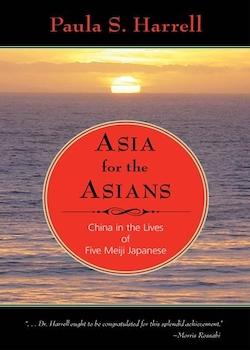Asia for the Asians: China in the Lives of Five Meiji Japanese

By Paula S. Harrell
A study of the Weatherhead East Asian Institute, Columbia University,
Merwin Asia, Portland, Maine, 2012
406 pages, including notes, bibliography and index, ISBN 978-1-97385-20-0
Review by Sir Hugh Cortazzi
In this interesting study of five Japanese personalities of the Meiji era, who were closely involved with Chinese modernization, Dr Harrell shows that the relationship between Japan and China was not always confrontational and that there were many influential Japanese who worked in their differing ways for better understanding between Japanese and Chinese. Dr Harrell, who is a China-Japan scholar specializing in twentieth century and contemporary history, brings to this carefully researched book a new insight into some of the Japanese personalities who worked in China during, and subsequent to, the Meiji period.
Dr Harrell emphasises that the five personalities in her study as well as other Japanese, who spent years in China either as employees of the Chinese government or in other capacities, were not sent there by the Japanese authorities but went there by their own choice. Their choice reflected the extent of the debt Japanese culture owed to China and to the fact that Confucian philosophy was embedded in Japanese thought. But Japan’s success in modernization often led to a somewhat patronising tone in their assessments which in turn inevitably rankled in Chinese minds.
The first personality covered by Dr. Harrell is Prince Atsumaro Konoe [近衛 篤麿] who became the first president of the Dõbunkai (Comon Culture Society – 同文会) in 1898 ‘to promote greater understanding of China in Japan.’ Konoe was part of the Meiji Emperor’s inner circle and head of the House of Peers. Both within Japan and on his visits to China he spoke with authority. He saw the need for political change in China on the lines of the changes made in Japan following the Meiji Restoration. Harrell notes (page 313) that ‘He was convinced that a strong partnership between the two rising Asian nations was in their mutual interest at many levels, particularly as a counterweight to Western dominance in Asia. This was the message of Asia for the Asians. He liked to call the new policy an Asian Monroe Doctrine.’ The Japanese defeat of Czarist Russia in 1905 was seen by the Chinese as an Asian triumph. ‘Thousands of Chinese students flocked to Tokyo to learn the lessons of Japan’s success.’ But Asia could not be isolated from the rest of the world.
Unokichi Hattori [服部宇之吉], who is Dr Harrell’s second subject, ‘had studied China his entire school career’ and ‘had a thorough knowledge of Chinese philosophy, history and traditional institutions.’ His experiences in Peking during the Boxer rebellion had a profound effect on him. After study in Germany he returned to China to become head of the teacher training division at the newly established Peking (Beijing) University, but the terms of his contract were vague and he was often frustrated. He regretted that the Chinese ‘failed to understand the real Japan.’ Hattori noted that the Chinese were using an increasing number of Japanese terms and idioms both because of the significant presence of Japanese advisers and because ‘hundreds of Chinese students educated in Japan were…taking posts in new government agencies.’ He doubted, however, whether ‘truly close relationships’ at a personal level could be developed (page 119). Hattori and other Japanese employed by the Chinese authorities were sceptical whether China was able ‘to govern itself.’
Misako Kawahara [河原操子] was the only woman among the five. Her main concern was women’s education.
Naniwa Kawashima [川島浪速] was employed to advise on police reform. He lived in China for twenty five years and was a dedicated student of Chinese history and language. He was vehemently anti-Western and thought that war with the United States was inevitable. He favoured ‘the secessionist aspirations of China’s ethnic minorities’ and pressed his views in no uncertain terms on the army general staff in Tokyo. In 1926 he told a Tokyo audience that after years of experience of the Chinese character he had ‘come to the painful conclusion…that the Chinese people are beyond hope’ because they were like ‘loose sand [p.223].’
Dr Harrell’s last subject is Nagao Ariga [有賀長雄], renowned as an international jurist who became constitutional adviser to Yuan Shikai [袁世凯]. Ariga argued strongly against group V in the 21 demands [二十一條] which Japan made on China in 1915. The Japanese leadership in the genro [extraconstitutional oligarchy that dominated the Japanese government] accepted the arguments and Takaaki Kato [加藤 高明], then Foreign Minister, had to resign. Ariga’s importance lies more in his role in establishing the Japan Red Cross and in relation to the Hague Peace Conferences than in the China context, but Dr Harrell’s portrait of him is well drawn.
It is impossible in a short review to do justice to these five portraits or to bring out adequately the salient points which Dr Harrell makes about the Japanese role in the modernisation of China. Students of Far Eastern History who study these five portraits will realize that attempts by Chinese, Japanese and Western scholars to summarize the background to Sino-Japanese antagonism often over simplify what was a complex and multi-layered relationship.

